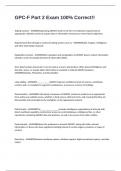GPC-F Part 2 Exam 100% Correct!!
Tasking involves - ANSWERSexpressing GEOINT needs in the form of collection requirements to
appropriate collection assets to acquire data or information necessary to meet mission objectives.
Requirements flow through a variety of tasking systems such as - ANSWERSGl&S, imagery, intelligence,
and other information channels.
Exploitation involves - ANSWERSthe evaluation and manipulation of GEOINT data to extract information
related to a list of essential elements of information (EEis}.
Once data has been processed, it can be used as a source and produce either general intelligence and
describe, assess, or visually depict information in standard or tailored GEOINT products. -
ANSWERSAnalysis, Production, and Visualization
value adding - ANSWERS_____ ______GEOINT improves confidence levels of sources, contributes
content, and I or metadata to augment completeness, accuracy or currency of holdings.
Dissemination - ANSWERSis the timely conveyance of GEOINT content or products in an appropriate
form and by any suitable means, whether in hard copy or electronic form, and ensuring that they are
discoverable and retrievable by the warfighter on the appropriate network.
Pull Principle - ANSWERSThe ____ ___________ provides intelligence organizations at all levels with
direct reachback capability via electronic access to central databases, intelligence files, or other
repositories containing GEOINT data and products, as well as to services from other entities.
Push principle - ANSWERSallows the producers to transmit GEOINT, along with other relevant
information, to those who have registered standing interest in certain regions, products, or types of
content.
Data Entry - ANSWERSManual coordinate capture, attribute capture, digital coordinate capture, and data
import
, Editing - ANSWERSManual point, line and area feature editing, manual attribute editing, and automated
error detection and editing
Data Management - ANSWERSCopy, subset, merge data, versioning, data registration and projection,
summarization, data reduction, compression, documentation and indexing
7 parameter transformation - ANSWERSdo account for the rotational differences in the axes and the
scale differences of the ellipsoids.
Geospatial Intelligence - ANSWERSThe exploitation and analysis of imagery and geospatial information to
describe, assess, and visually depict physical features and geographically referenced activities on the
Earth
GEOINT data - ANSWERSany data used to create GEOINT, which can be derived from multiple classified
or unclassified sources.
HUMINT, SIGINT, MASINT, and OSINT. - ANSWERSThe GEOINT discipline incorporates data from other
intelligence disciplines, such as
GPE - ANSWERSGeospatial Intelligence Preparation of the Environment
Imagery - ANSWERSA likeness or presentation of any natural or man-made feature or related object or
activity and the positional data acquired at the same time the likeness or representation was acquired,
including products produced by space-based national intelligence reconnaissance systems, and
likenesses or presentations produced by satellites, airborne platforms, unmanned aerial vehicles, or
other similar means (except that such term does not include handheld or clandestine photography taken
by or on behalf of human intelligence collection organizations).
Imagery Intelligence - ANSWERSThe technical, geographic, and intelligence information derived through
the interpretation or analysis of imagery and collateral materials.




